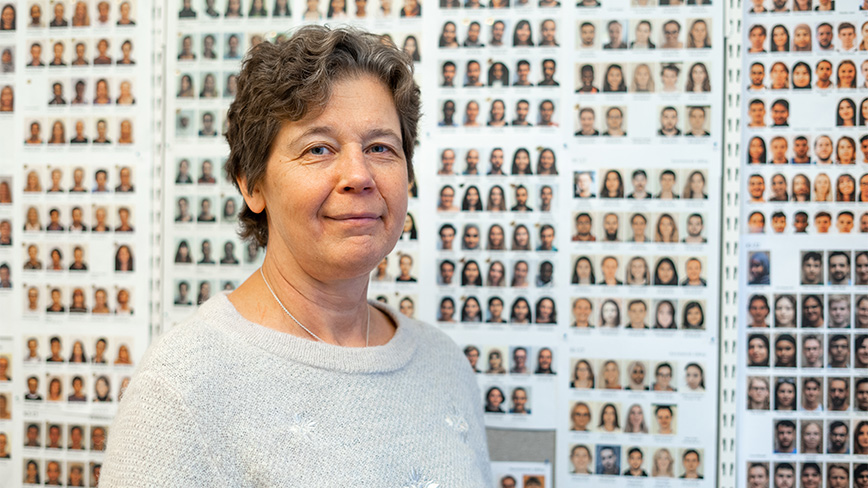The research engineer who realised that teaching that was her thing

The department of Engineering Pedagogics, led by Sara Naumann, is an odd bird among KTH’s departments. It deals almost exclusively with education and has the overall responsibility for the qualifying education Technical Preparatory Year at KTH Campus, as well as the bachelor’s programme in Chemical Engineering.
“What keeps us all together here is an interest in teaching,” says Sara Naumann.
The walls in her office are covered with portraits of the students from all classes of the bachelor’s programme, starting from 1996. There are around 50 students per year, except for the years 2002 to 2004, when the recruitment saw a decline and the classes only consisted of around 20 people. Sara Naumann says that she remembers all the students that have passed through the years, except for those who only stayed for a couple of weeks.
“Almost all the courses of the programmes are given by teachers at the department. It makes it easy to ensure that we get a good progression and that different courses fit together. Another advantage is that we get to know the students in a nice way, in both the preparatory year and the bachelor’s programme, and that we can follow their development,” says Sara Naumann.
The common denominator for the department’s personnel is an interest in pedagogics and the development and personal growth of their students.
“This is evident in all the discussions we have about educational issues. It does not matter if you teach mathematics or chemistry, what keeps us all together here is the interest in teaching,” says Sara Naumann.
Many trained educators
I high proportion of the coworkers at the Department of Engineering Pedagogics are trained educators, several of them are high school teachers. Another category are engineers who have themselves studied at KTH, or university chemists. Many of them have completed their PhD.
”I think this is the case for a lot of us, that you have gradually discovered that it is teaching that you are passionate about, pedagogics and didactics,” says Sara Naumann.
That was the case for her as well. She studied at KTH, worked for some time as a research engineer, but realised that it was teaching that was her thing. Now she has worked at KTH for over 30 years.
”We are all lecturers. It is special because we are not included in KTH’s career development programme Tenure track. It means that we lack the career paths that exist for the faculty and this makes it hard to recruit young people. The consequence is that we have a relatively high average age and that will eventually cause problems when we all retire.”
250 beginners per year
The Technical Preparatory Yearis a so called qualifying education that makes it possible to get a high school qualification in chemistry, physics and mathematics, in order to be able to apply to KTH. Those who have completed the preparatory year also have a guaranteed place in one of KTH’s engineering programmes.
”It is a year of intense studies. The preparatory year is big and exists at three of KTH’s campuses. At Valhallavägen, 250 beginners are admitted per year, and they are divided into five classes. This means that every class has its teachers in mathematics, physics and chemistry. A typical preparatory year teacher has two subjects, mathematics and physics or mathematics and chemistry, and teaches one course in each subject every study period. As a teacher, you have many teaching hours per week,” says Sara Naumann.
What challenges do you face?
”One challenge is students with limited prior knowledge. They have passed the courses at high school, but still do not have enough knowledge to pass the programmes. It is a challenge to help them get on track.”
“The challenge for the bachelor’s programme in Chemical engineering is to recruit enough applicants to get a good selection, this also applies to the master’s programme in Chemical engineering. It is a challenge in the whole world that young people do not choose chemistry programmes. Companies, media and trade associations have to show which opportunities there are in solving problems within the environment, climate issues, energy, food supply and clean water. Many of the UN’s global goals have a strong connection to chemistry and chemical engineering so it is important to highlight it.”
“Everyone is passionate about teaching”
Sara Naumann thinks it is fun and exciting to work with young people and get to follow them in an eventful period of in life. This mainly applies to the bachelor engineers, whose education is longer and who the teachers get to follow until they graduate as full-fledged engineers.
”I often have contact with them as alumni, when we need people for projects within industry, degree projects and guest lecturers. So we try to work actively with our alumni, for feedback on what works in the education, as well as practically, for contributing to the programmes and being visible to our current students.”
“We are a collection of very committed teachers working together, a cool environment where everyone is passionate about teaching and the students’ development. What is unique is that no other department is engaged in teaching only. We do not fit into the KTH model and are somewhat of an odd bird,” says Sara Naumann.
Text: Sabina Fabrizi
